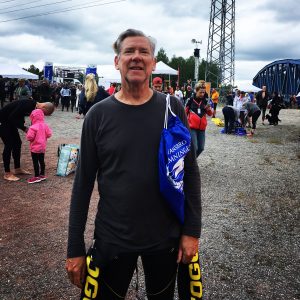 I registered for the Vansbro swim not just because I enjoy swimming long distances but because I thought it would be a good way to see another side of Swedish life, away from the
I registered for the Vansbro swim not just because I enjoy swimming long distances but because I thought it would be a good way to see another side of Swedish life, away from the
quaint streets and museums of Stockholm.
Once in Stockholm I booked a return trip on a bus that was offered on a email newsletter I’d received from the Vansbrosimningen (Vansbro swim event) organisers, in Swedish of course, but I could roughly decifer it and some locals at a hostel were happy to translate. The bus left at 7.30am on Friday morning from the Central Station, T-Centralum, not an easy place to figure out so I went the day before to find out where my bus would leave. T-Centralum is a sprawling hub for commuter trains, trams, metro trains, local and nationwide buses, and it’s on various levels with linked buildings. If I was carrying my gear and running late there’s nothing worse than trying to figure out a big station when you’re all weighed down, and of course, all the signage is in Swedish. So Friday morning was easy, I went straight to Gate 16 on Level 2 – and there it was, a bus being loading up with happy swimmers.
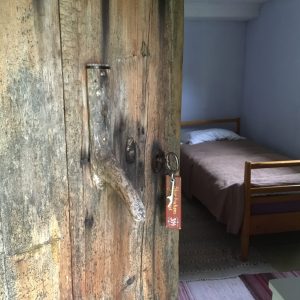
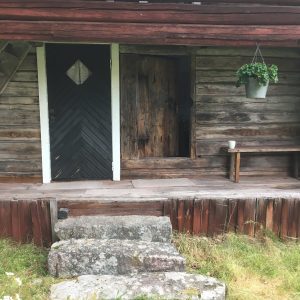
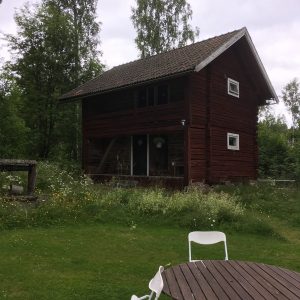 My accomodation was booked 6 months ago, there was nothing available in Vansbro even back then so I booked a place 18km out of town thinking there would be some kind of bus service or at least some other swimmers staying who I could get a lift with.
My accomodation was booked 6 months ago, there was nothing available in Vansbro even back then so I booked a place 18km out of town thinking there would be some kind of bus service or at least some other swimmers staying who I could get a lift with.
I registered for the swim event first, everything is so well organised, I got my goodie bag; a cap, a meal ticket, a wristband with the timing chip, and a plastic bag with my number on it that you put your things in at the start of the swim that they transport to the finish.
My accomodation turned out to be a problem. There was a local bus 3 times a day but the lodge was 2 km from the turnoff. It was a long walk in the sun and when I got there it was an old smelly place – completely unlike the clean modern hostels I had been used to in Stockholm. The old toothless owner said my cabin was 200 years old and built by hand, but there was no ensuite, and all the facilities where in the main house.
Next morning I had the free breakfast; a boiled egg, fresh-baked fruit loaf, sliced ham and a slices from a massive block of cheese, and all the usual cereals, and I checked out. I have to admit this place was an authentic experience, the bread was so fresh, still moist and warm, and it was like an old homestead from a by-gone age. But it was going to be too hard getting back there after the swim because I wanted to stay for the evening entertainment and I knew there would not be a late bus. The old toothless guy insisted on charging me for the two nights, I was hoping he’d waive the second night but as a late cancellation I had to accept it. I managed to get a lift with a couple going to Vansbro and once there asked about accomodation in Vansbro. I had heard some of the schools offer swim visitors dorm places in the classrooms. The school was 10 minutes walk from the centre of town and with that organised I was happy everything was going to work out.
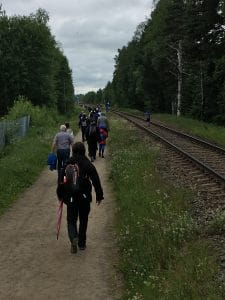
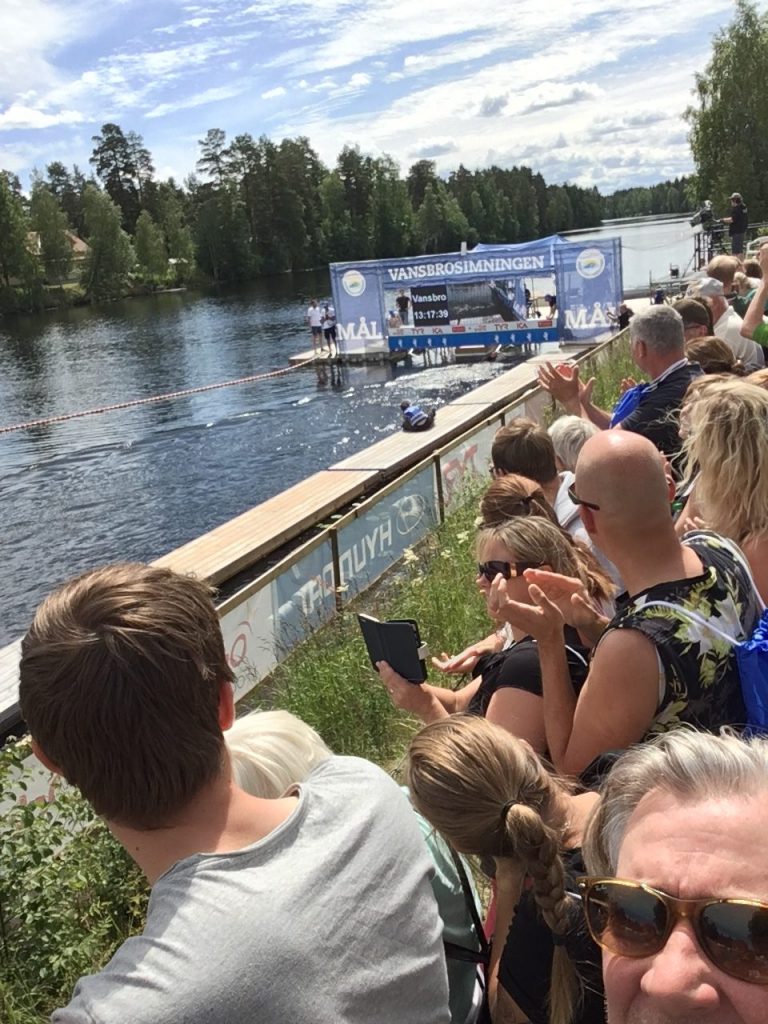
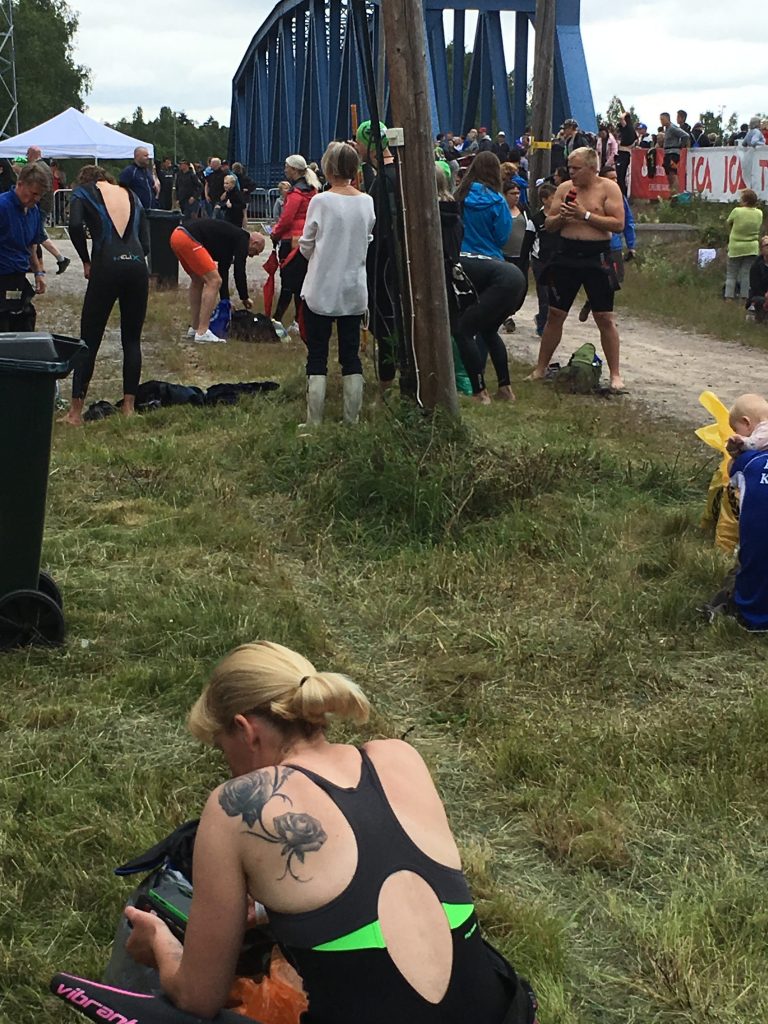 To get to the start of the swim you need to walk, it’s a track through the birch and pines alongside a railway line. They process about 6,500 swimmers that day by sending them off in waves of a hundred every 10 minutes, and each wave has a different coloured cap. My cap was pink but I never saw the gathering of ‘pink caps’ at my allocated time, only green caps. Suddenly they announced my name and country. It surprised me because the announcer had been speaking non-stop Swedish, and then I heard my name. He looked up and I waved both my arms, ‘I’m here!’ I then realised the pink caps were special entries of one some kind or another – another pink capped person had their birthday that day and they announced her too.
To get to the start of the swim you need to walk, it’s a track through the birch and pines alongside a railway line. They process about 6,500 swimmers that day by sending them off in waves of a hundred every 10 minutes, and each wave has a different coloured cap. My cap was pink but I never saw the gathering of ‘pink caps’ at my allocated time, only green caps. Suddenly they announced my name and country. It surprised me because the announcer had been speaking non-stop Swedish, and then I heard my name. He looked up and I waved both my arms, ‘I’m here!’ I then realised the pink caps were special entries of one some kind or another – another pink capped person had their birthday that day and they announced her too.
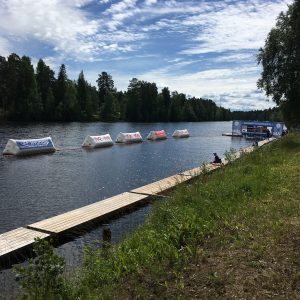
The water was 17º, which is not cold at all. I was thinking my time would be about 1.5 hours. Once underway I really enjoyed myself, I never got tired and felt relaxed and comfortable, just a bit of cramp started to clinch my left calf at one stage. Occasionally, I stopped, lifted off my goggles, trod water and had a look around. There was a string quartet playing under a gazebo at the river side, families picnicing and I waved to people who waved back. The first 2 km is downstream, nice, and the last 1 km is upstream but there’s barely any upstream current to speak of. I had started with the green caps and was eventually swimming among the red caps who were a previous wave, so I figured I was going ok.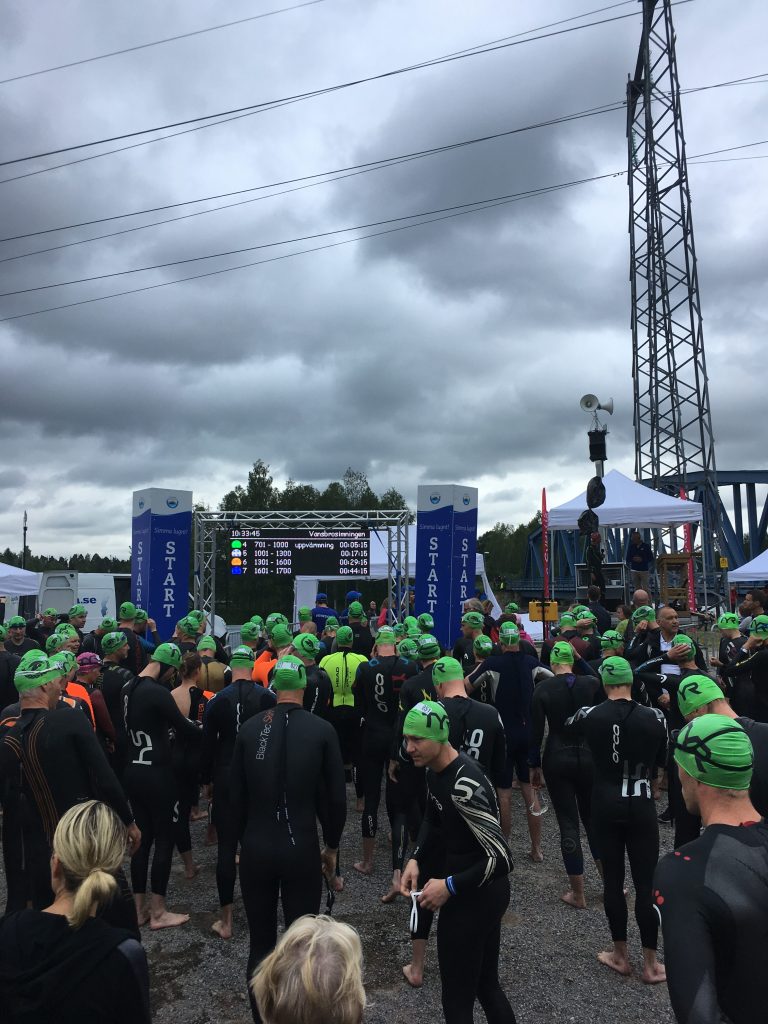
I was surprised to discover the majority of the Swedes don’t swim freestyle, (or crawl), they swim a variation of breast stroke without ducking their head in the water. They kind of bob along in what we’d call a sort of dog paddle, except with a breast stroke and kick, so I guess you could call it a ‘frog paddle’.
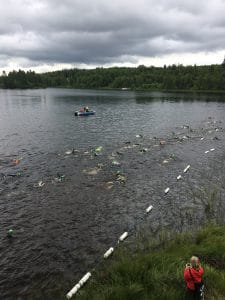
Anyway, it’s pretty slow and I found I was crashing into swimmers all the way. My final time was 59 minutes and 56 seconds. Yes, woah!, sub 60! I even did some back stroke in the final section just because I was feeling so good.
From there everything is laid on; a warm energy drink, a medal, bag collection – and then I entered the big shower enclosure. Here I was confronted with hundreds of naked blokes all taking warm showers or waiting for a shower – never seen that before. I followed suit only to realise I didn’t actually have any pants, just a top and a polar fleece jacket because I’d put my wetsuit on at the Information Centre where I put my bag in storage. It’s never very pleasant putting a wet and cold wetsuit back on.
Many people were there as part of the Swedish Classic where you need to complete 4 events within one year; cross country sking 60 or 90km in winter, bike 300km in spring, swim 3km in summer, and run 30km in autumn. It’s really popular and thousands do it, some year after year.
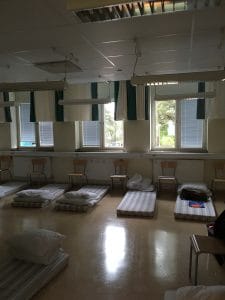 After changing at the Info Centre I went down the road to Smedbergsskolan School; a modern, clean, and again, well organised place with friendly helpful people, and was shown a room lined with fresh mattresses and new white duvees and pillows. I made my bed, lay down and fell asleep. It turned out we had only four people in our room. It was warm, dry and quiet – and, a bonus – breakfast was included in the price which was 390 krona, or about NZ$62.
After changing at the Info Centre I went down the road to Smedbergsskolan School; a modern, clean, and again, well organised place with friendly helpful people, and was shown a room lined with fresh mattresses and new white duvees and pillows. I made my bed, lay down and fell asleep. It turned out we had only four people in our room. It was warm, dry and quiet – and, a bonus – breakfast was included in the price which was 390 krona, or about NZ$62.
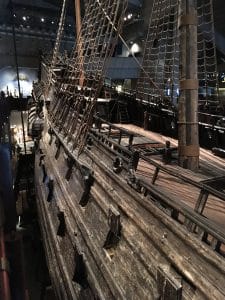 Yesterday my phone battery went flat so I had to use a paper map and it was so easy. No fiddling around zooming in and out of a tiny screen. The maps and apps on the phone are brilliant tools but they give you so much more than you really. I have trouble seeing the important icons for the things I really need like the Metro stations among the clutter of other commercial locations like restaurants and shops that fill up the screen. I have switched between Maps and Google Maps to find the best and I think Maps is the quickest but the directions are so big they take up a third of the screen – I think Maps it was made for people in cars. Google Maps has more stuff but sometimes it’s far too much stuff. When you select a route in Google Maps it puts a dotted line right over the name of the street you need to go down and you spend so much time zooming in and out trying to read it. Finding where all the dropped pins are is a hassle. The phoneis an amazing asset in these unknown cities but you still need to flip over to other apps to see the metro map or the bus and train routes – flip, flip, fiddle, faddle – it was a such a nice break air to use a regular paper map – at a single glance I could see where I was, the direction I wanted to go and the all the nearest metro stops – and I could scribble on it. I was brought up using paper maps, from ordinance survey maps to the A-Z of London that I knew inside out – it was nice to use some old skills. In fact, I’ve now decided to best and most fun way to get around Stockholm is on a bike with a paper map.
Yesterday my phone battery went flat so I had to use a paper map and it was so easy. No fiddling around zooming in and out of a tiny screen. The maps and apps on the phone are brilliant tools but they give you so much more than you really. I have trouble seeing the important icons for the things I really need like the Metro stations among the clutter of other commercial locations like restaurants and shops that fill up the screen. I have switched between Maps and Google Maps to find the best and I think Maps is the quickest but the directions are so big they take up a third of the screen – I think Maps it was made for people in cars. Google Maps has more stuff but sometimes it’s far too much stuff. When you select a route in Google Maps it puts a dotted line right over the name of the street you need to go down and you spend so much time zooming in and out trying to read it. Finding where all the dropped pins are is a hassle. The phoneis an amazing asset in these unknown cities but you still need to flip over to other apps to see the metro map or the bus and train routes – flip, flip, fiddle, faddle – it was a such a nice break air to use a regular paper map – at a single glance I could see where I was, the direction I wanted to go and the all the nearest metro stops – and I could scribble on it. I was brought up using paper maps, from ordinance survey maps to the A-Z of London that I knew inside out – it was nice to use some old skills. In fact, I’ve now decided to best and most fun way to get around Stockholm is on a bike with a paper map.
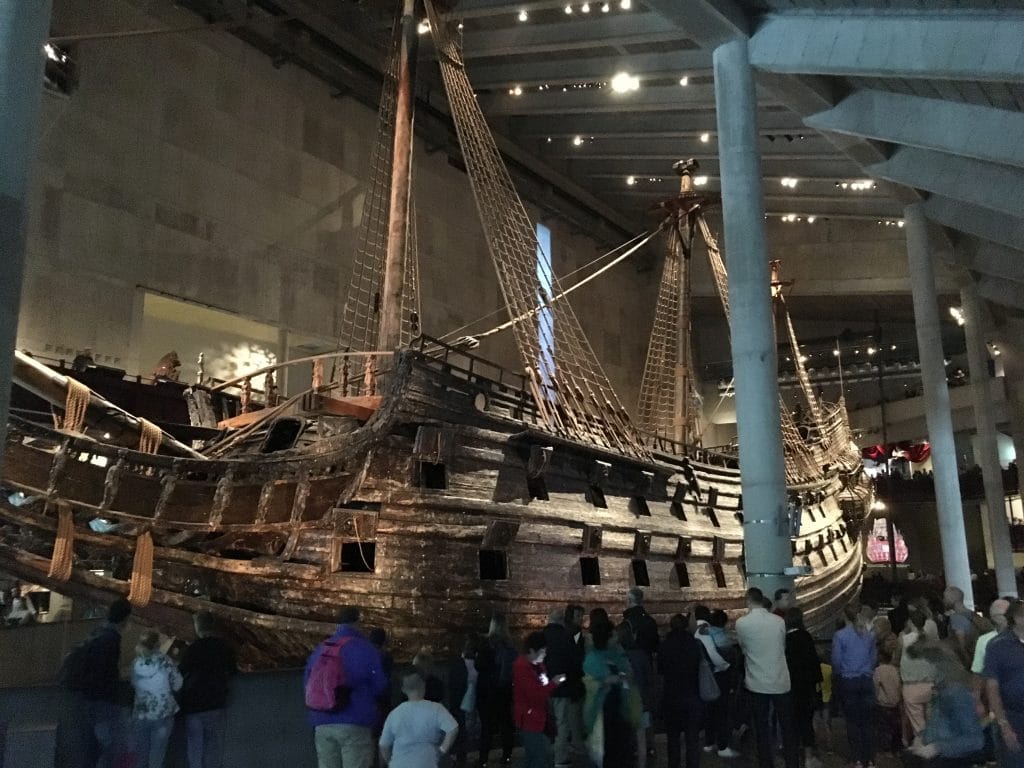

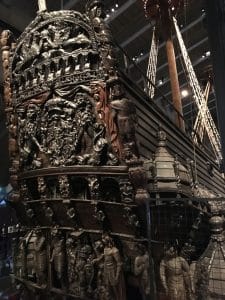
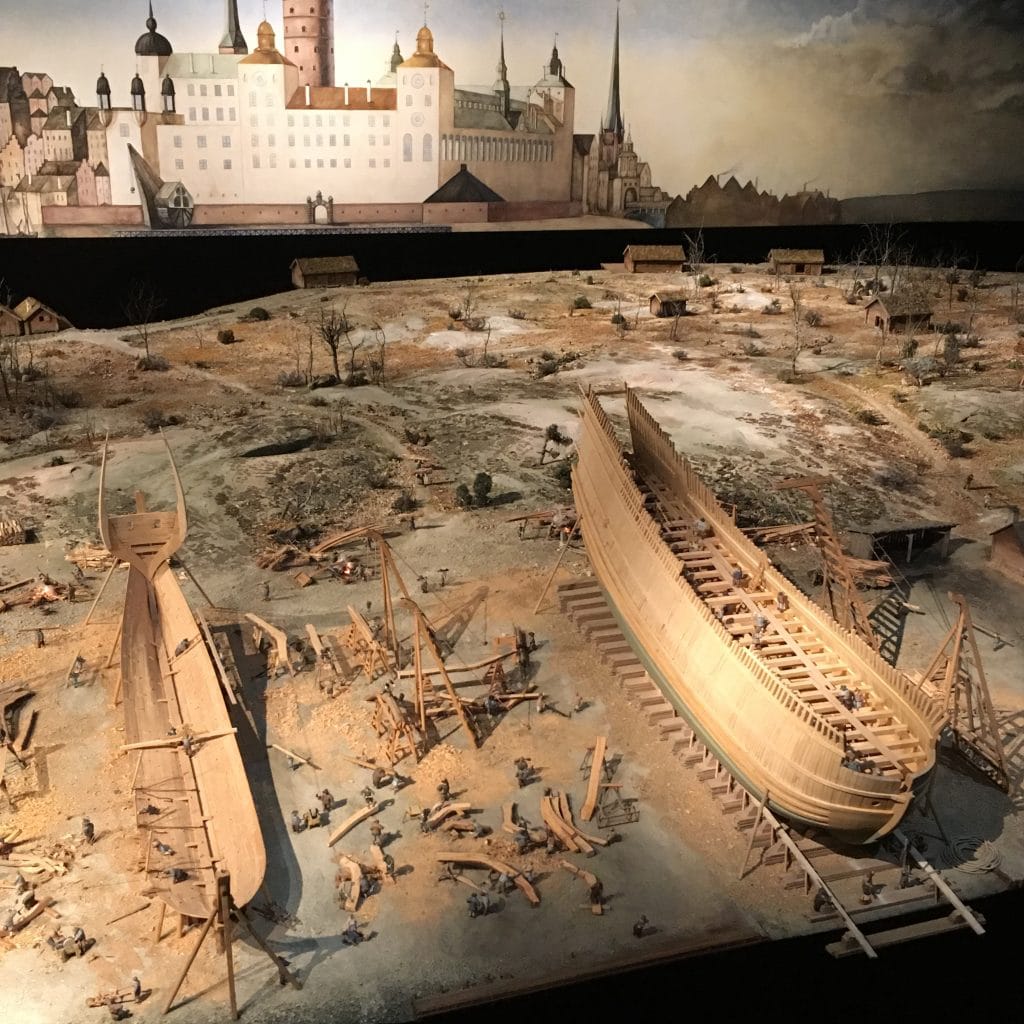

 A ferry ride took me to the Museum of Modern Art on a nearby island where, apart from the permanent exhibition, there was an exhibition of work by the architect, furniture and fabric designer Josef Frank.
A ferry ride took me to the Museum of Modern Art on a nearby island where, apart from the permanent exhibition, there was an exhibition of work by the architect, furniture and fabric designer Josef Frank.